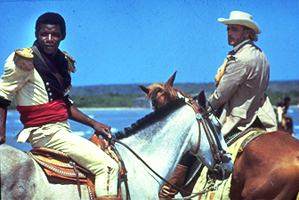

Italy/France action
1969
color 112 min.
Director: Gillo Pontecorvo
CLV: out-of-print collectible
1 disc, catalog # CC1261L
 This rarely seen, overlooked gem, featuring what may be one of Marlon
Brando's most fascinating characterizations, was Gillo Pontecorvo's
worthy follow-up to his political masterpiece The Battle of
Algiers. The brilliant radical Italian director achieved something
unique in cinema, by wedding, as he said, "the romantic adventure and
the film of ideas." Although Burn! recalls an Errol Flynn
swashbuckler, it is primarily a devastating attack on imperialistic
nations -- particularly 19th-century Portugal and Great Britain
depicted in the film, and by implication, the United States and its
involvement in the Vietnam war.
This rarely seen, overlooked gem, featuring what may be one of Marlon
Brando's most fascinating characterizations, was Gillo Pontecorvo's
worthy follow-up to his political masterpiece The Battle of
Algiers. The brilliant radical Italian director achieved something
unique in cinema, by wedding, as he said, "the romantic adventure and
the film of ideas." Although Burn! recalls an Errol Flynn
swashbuckler, it is primarily a devastating attack on imperialistic
nations -- particularly 19th-century Portugal and Great Britain
depicted in the film, and by implication, the United States and its
involvement in the Vietnam war.
The Battle of Algiers, which Pontecorvo made
documentary-style, was filmed with a cast of unknowns in
grainy/scratchy black and white for a mere $800,000. Burn!,
written by Franco Solinas and Giorgio Arlorio, cost $3,000,000, with
an international superstar, beautiful color cinematography, great
attention to costumes and pageantry, and a rousing score by Ennio
Morricone (who scored all of Sergio Leone's "spaghetti" westerns). The
injection of spectacle, however, didn't mean Pontecorvo intended to
tone down the politics. Whereas Battle is about the tactics
employed by urban revolutionaries and counter-revolutionaries in
cities around the world where oppression exists (not just the Algiers
of 1954-63), Burn! is the perfect complement, dealing with the
tactics employed by both peasant-slave revolutionaries and
imperialists in the Third World. Its theme is identical: revolutions
against colonialists do not end when leaders are killed, but go on and
on, until there is total success.
Inspired by historical events, Burn! begins in 1845 on a
Caribbean island controlled by Portugal (fearing a Spanish boycott,
United Artists "suggested" Pontecorvo switch the controlling country
from the historically accurate Spain). In the 16th century, the
Portuguese set fire to the island to quell the native uprising,
exterminating the entire population. They then imported black slaves
from Africa to replace the dead Indians on the island's sugar
plantations.
Egomaniacal British secret agent Sir William Walker (Brando)
arrives at the island to instigate a slave revolt. The intellectual,
foppish Walker befriends a defiant black dock worker, Josˇ Dolores
(Evaristo Marquez), and preaches to him about freedom. He persuades
Dolores to commit a rebellious act, which leads to full-fledged
"spontaneous revolution" by blacks throughout the island. With Walker
teaching the hero Dolores and his followers how to fight, they chase
the Portuguese off the island. They expect freedom, but Walker
convinces them they aren't equipped to rule an island. Instead he
installs a native leader who will be a puppet for the British. Walker
has done his job well.
For the first half of the film, Walker is our hero. He is brave,
pragmatic, smart, witty, and seemingly respectful of Dolores and the
other blacks. But in the second half, which takes place ten years
later, Walker returns to the island to put down an armed insurrection
led by Dolores. He burns the countryside, smoking out and executing
the rebels, and arrests his former friend. With this heinous act
Walker becomes a loathsome figure, one of the many brilliant men in
history who choose to serve the wrong side.
Marlon Brando's most effective scenes are those with Marquez, who
also has tremendous presence. Who is this unknown actor who holds his
own with Brando, radiating the authority of Paul Robeson in his most
dignified roles? He was an illiterate Colombian cane-cutter, who had
never even seen a movie. He gives an amazing performance, particularly
considering that Brando had to cue Marquez by nudging him below frame
level every time he was supposed to speak or move.
Brando became ill during the lengthy, strenuous production,
necessitating changes in location filming from Colombia to such
diverse locales as the Virgin Islands, France, Rome, and Morocco. Yet,
he gives one of his most compelling, cerebral performances. Burt
Lancaster and Richard Burton were considered for Walker, but
Pontecorvo decided that "the only one who could do this role was
Brando. There are many moments when there is no time for dialogue, and
when we need the synthesis of Brando's acting and his face. When
things are psychological, we trust the face of Brando."
-- DANNY PEARY
Credits
Director: Gillo Pontecorvo
Producer: Alberto Grimaldi
Screenplay: Franco Solinas, Giorgio Arlorio
Cinematographer: Marcello Gatti
Music: Ennio Morricone
Art Director: Piero Gherardi
Editor: Mario Morra
Set Decorator: Francesco Bronzi
Special Effects: Aldo Gasparri
Costumes: Piero Gherardi
Transfer
This edition of Burn! was transferred from a 35mm master
print. The soundtrack was mastered from a 35mm magnetic track.





